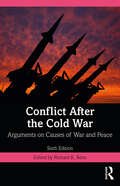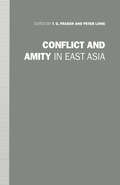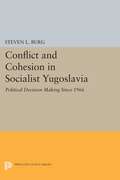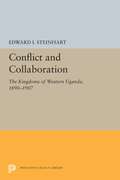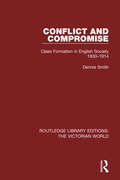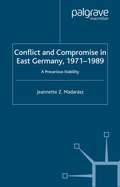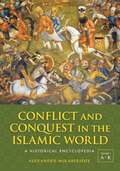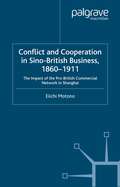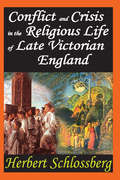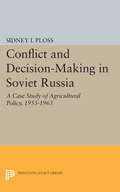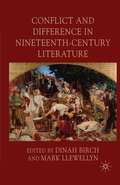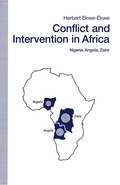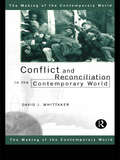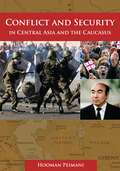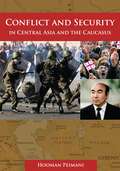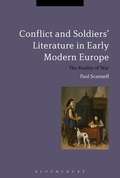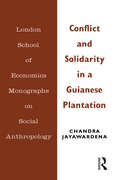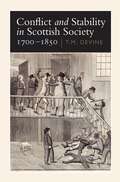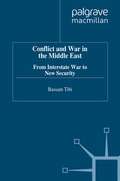- Table View
- List View
Conflict After the Cold War: Arguments on Causes of War and Peace
by Richard K. BettsEdited by one of the most renowned scholars in the field, Richard K. Betts’s Conflict After the Cold War assembles classic and contemporary readings on enduring problems of international security. Offering broad historical and philosophical breadth, the carefully chosen and excerpted selections in this popular reader help students engage in key debates over the future of war and the new forms that violent conflict will take. Conflict After the Cold War encourages closer scrutiny of the political, economic, social, and military factors that drive war and peace. New to the Sixth Edition Eight new readings covering issues that have grown in salience since the previous edition or that present new interpretations of answers to old problems, including pieces by Robert Kagan, Edward O. Wilson, Scott D. Sagan, Robert Jervis and Jason Healey, Jacqueline L. Hazelton, Oystein Tunsjo, and Michael Beckley. Updated volume and chapter introductions and a new reading by Richard K. Betts.
Conflict After the Cold War: Arguments on Causes of War and Peace
by Richard K. BettsEdited by one of the most renowned scholars in the field, Richard K. Betts’s Conflict After the Cold War assembles classic and contemporary readings on enduring problems of international security. Offering broad historical and philosophical breadth, the carefully chosen and excerpted selections in this popular reader help students engage in key debates over the future of war and the new forms that violent conflict will take. Conflict After the Cold War encourages closer scrutiny of the political, economic, social, and military factors that drive war and peace. New to the Sixth Edition Eight new readings covering issues that have grown in salience since the previous edition or that present new interpretations of answers to old problems, including pieces by Robert Kagan, Edward O. Wilson, Scott D. Sagan, Robert Jervis and Jason Healey, Jacqueline L. Hazelton, Oystein Tunsjo, and Michael Beckley. Updated volume and chapter introductions and a new reading by Richard K. Betts.
Conflict and Amity in East Asia: Essays in Honour of Ian Nish
by T. G. Fraser Peter LoweThis volume examines aspects of international relations in East Asia from 1895 to the present with particular reference to the role of Japan: the principal theme pursues the antecedents, nature, and consequences of the Pacific war (1941-5). The topics examined focus on the course of Japanese expansion, American-Japanese relations, Japanese reactions to war, the role of women during the conflicts in China and the Pacific, Anglo-American policies towards Japan, China, and Korea after 1945, Japanese-New Zealand relations, and Anglo-Japanese relations from the 1950s to the 1980s.
Conflict and Cohesion in Socialist Yugoslavia: Political Decision Making Since 1966 (PDF)
by Steven L. BurgSteven L. Burg views Yugoslav politics since 1966 in terms of the communist leadership's efforts to preserve political cohesion in the face of powerfully divisive domestic conflicts. He examines the bases of those conflicts, their suppression with the establishment of communist power, and their reemergence and escalation into crisis during the late 1960s and early 1970s--a period when the conflict between hostile nationalisms, reinforced by regional economic differences, directly challenged communist power.Originally published in 1983.The Princeton Legacy Library uses the latest print-on-demand technology to again make available previously out-of-print books from the distinguished backlist of Princeton University Press. These editions preserve the original texts of these important books while presenting them in durable paperback and hardcover editions. The goal of the Princeton Legacy Library is to vastly increase access to the rich scholarly heritage found in the thousands of books published by Princeton University Press since its founding in 1905.
Conflict and Collaboration: The Kingdoms of Western Uganda, 1890-1907 (Princeton Legacy Library #5479)
by Edward I. SteinhartComic elements in Shakespeare's tragedies have often been noted, but while most critics have tended to concentrate on humorous interludes or on a single play, Susan Snyder seeks a more comprehensive understanding of how Shakespeare used the conventions, structures, and assumptions of comedy in his tragic writing. She argues that Shakespeare's early mastery of romantic comedy deeply influenced his tragedies both in dramaturgy and in the expression and development of his tragic vision. From this perspective she sheds new light on Romeo and Juliet, Hamlet, Othello, and King Lear.The author shows Shakespeare's tragic vision evolving as he moves through three possibilities: comedy and tragedy functioning first as polar opposites, later as two sides of the same coin, and finally as two elements in a single compound.In the four plays examined here, Professor Snyder finds that traditional comic structures and assumptions operate in several ways to shape the tragedy: they set up expectations which when proven false reinforce the movement into tragic inevitability; they underline tragic awareness by a pointed irrelevance; they establish a point of departure for tragedy when comedy's happy assumptions reveal their paradoxical "shadow" side; and they become part of the tragedy itself wehen the comic elements threaten the tragic hero with insignificance and absurdity.Susan Snyder is Professor of English at Swarthmore College.Originally published in 1978.The Princeton Legacy Library uses the latest print-on-demand technology to again make available previously out-of-print books from the distinguished backlist of Princeton University Press. These editions preserve the original texts of these important books while presenting them in durable paperback and hardcover editions. The goal of the Princeton Legacy Library is to vastly increase access to the rich scholarly heritage found in the thousands of books published by Princeton University Press since its founding in 1905.
Conflict and Compromise: Class Formation in English Society 1830-1914 (Routledge Library Editions: The Victorian World)
by Dennis SmithFirst published in 1982, this study explores the dynamics of class formation during the vital decades between 1830 and 1914, when a rising urban industrial order was developing in complex interdependence with a declining rural agrarian order. The book follows the divergent paths of two cities - Birmingham and Sheffield – in their social development. These paths reflect the complex process of conflict and compromise as the ‘old’ order was gradually replaced by the ‘new’. It studies in detail many aspects of social life that were affected by these changes such as education, public administration, political structures, public administration, religion, the professions, popular culture and family. This book will be of interest to those studying Victorian history and sociology.
Conflict and Compromise: Class Formation in English Society 1830-1914 (Routledge Library Editions: The Victorian World)
by Dennis SmithFirst published in 1982, this study explores the dynamics of class formation during the vital decades between 1830 and 1914, when a rising urban industrial order was developing in complex interdependence with a declining rural agrarian order. The book follows the divergent paths of two cities - Birmingham and Sheffield – in their social development. These paths reflect the complex process of conflict and compromise as the ‘old’ order was gradually replaced by the ‘new’. It studies in detail many aspects of social life that were affected by these changes such as education, public administration, political structures, public administration, religion, the professions, popular culture and family. This book will be of interest to those studying Victorian history and sociology.
Conflict and Compromise in East Germany, 1971–1989: A Precarious Stability
by J. MadarászThis extensively researched empirical analysis of the GDR in the years 1971-1989 challenges current historical interpretations of GDR history. It focuses on four social groups - youth, women, writers and Christians - to highlight the stability of this socialist society until 1987. The strength of the regime is shown to have been based on a continuously negotiated process of give-and-take involving major parts of the population.
Conflict and Conquest in the Islamic World [2 volumes] [2 volumes]: 2 volumes [2 volumes]
A reference work that thoroughly documents the extensive military history of the Islamic world between the 7th century and the present day.Military-political conflict—and the resulting factionalism, shifts in leadership, and divergent belief systems—has been a constant and crucial part of the Islamic world. In order to fully grasp the cultural, social, or political aspects of Islam in the modern world, it is necessary to comprehend the rich tapestry of Islamic history from pre-Islamic times to the present, much of which involved armed conflict.Conflict and Conquest in the Islamic World: A Historical Encyclopedia provides hundreds of entries on wars, revolutions, sieges, institutions, leaders, armies, weapons, and other aspects of wars and military life, enabling readers to understand the complex role conflict has played in Islamic life throughout history and see how Islamic warfare has evolved over the centuries. This reference work covers not only the traditional Middle Eastern regions and countries but also provides relevant historical information regarding Islam in North Africa, Central Asia, Southeastern Asia, and Oceania.
Conflict and Cooperation in Sino-British Business, 1860–1911: The Impact of the Pro-British Commercial Network in Shanghai (St Antony's Series)
by E. MotonoThis is a study about the collapse of Chinese traditional commercial order in the late Qing period. It regards the process as an influence from the prevalence of pro-British Chinese commercial networks in the 1880s. Through the analysis of various Sino-British commercial conflicts after the Arrow war, this book reveals when and where such a commercial network was born and what impact it brought about on the Chinese society.
Conflict and Crisis in the Religious Life of Late Victorian England
by Herbert SchlossbergContrary to its popular image as dull and stodgy, the Victorian period was one of revolutionary change. In its politics, its art, its economic aff airs, its class relationships, and in its religion, change was constant. A half-century after Queen Victoria's death, it was said that she was born in one world and died in another. Th e most interesting and valuable studies of the period take the long view, as does Schlossberg, in his fascinating analysis of religious life in this period. For the Victorians, religion was not cordoned off from the push and shove of real life. Th e early evangelicals got off to a shaky start, beset by hostility, but the movement spread within the churches despite the suspicion in which it was held. Evangelicals, frequently called Puritans by those who opposed them, called for fundamental reforms in both the Church and the society; a social ethic was part of their program of religious renewal. Th eir moral sense explains the social activism of both Church of England Evangelicals and Dissenters, including the half-century crusade for the abolition of slavery. Schlossberg shows how religion in England dealt with such issues as science and the eff ect of German scholarship on religious thinking. Church history cannot simply be explained by its response to external forces as much as by the internal responses to those challenges. Th e nature of the religious enterprise itself, its theologians, clergy, lay people--like all people and all institutions--all responded with alternatives. Schlossberg helps us understand the Victorian period, as well as the increasing secularity of English life today.
Conflict and Crisis in the Religious Life of Late Victorian England
by Herbert SchlossbergContrary to its popular image as dull and stodgy, the Victorian period was one of revolutionary change. In its politics, its art, its economic aff airs, its class relationships, and in its religion, change was constant. A half-century after Queen Victoria's death, it was said that she was born in one world and died in another. Th e most interesting and valuable studies of the period take the long view, as does Schlossberg, in his fascinating analysis of religious life in this period. For the Victorians, religion was not cordoned off from the push and shove of real life. Th e early evangelicals got off to a shaky start, beset by hostility, but the movement spread within the churches despite the suspicion in which it was held. Evangelicals, frequently called Puritans by those who opposed them, called for fundamental reforms in both the Church and the society; a social ethic was part of their program of religious renewal. Th eir moral sense explains the social activism of both Church of England Evangelicals and Dissenters, including the half-century crusade for the abolition of slavery. Schlossberg shows how religion in England dealt with such issues as science and the eff ect of German scholarship on religious thinking. Church history cannot simply be explained by its response to external forces as much as by the internal responses to those challenges. Th e nature of the religious enterprise itself, its theologians, clergy, lay people--like all people and all institutions--all responded with alternatives. Schlossberg helps us understand the Victorian period, as well as the increasing secularity of English life today.
Conflict and Decision-Making in Soviet Russia: A Case Study of Agricultural Policy, 1953-1963 (PDF)
by Sidney I. PlossThis discussion of agricultural policy in the decade after Stalin shows how decisions are made and then enforced.Originally published in 1965.The Princeton Legacy Library uses the latest print-on-demand technology to again make available previously out-of-print books from the distinguished backlist of Princeton University Press. These editions preserve the original texts of these important books while presenting them in durable paperback and hardcover editions. The goal of the Princeton Legacy Library is to vastly increase access to the rich scholarly heritage found in the thousands of books published by Princeton University Press since its founding in 1905.
Conflict and Difference in Nineteenth-Century Literature
by D. Birch M. LlewellynHow should we understand Victorian conflict? The Victorians were divided between multiple views of the political, religious and social issues that motivated their changing aspirations. Such debates are a fundamental aspect of the literature of the period and these essays propose new ways of understanding their significance.
Conflict And Intervention In Africa: Nigeria Angola Zaire (pdf)
by G. Holderness J. Turner Nick PotterConflict and Reconciliation in the Contemporary World (The Making of the Contemporary World)
by David J. WhittakerConflict and Reconciliation in the Contemporary World gives a concise, original and multi-faceted introduction to the study of modern conflict situations. Using eight case- studies, from four continents: Yugoslavia, Israel, Northern Ireland, South Africa, El Salvador, Cambodia, Cyprus and Afghanistan, it includes discussion on: * threatened regional peace and security * cycles of internal discord, population displacement and violence * controversy over causes, progress and resolution * the value of external mediation, enforcement or intervention such as sanctions or "punishments" * means, timing and permanence of reconciliation.
Conflict and Reconciliation in the Contemporary World (The Making of the Contemporary World)
by David J. WhittakerConflict and Reconciliation in the Contemporary World gives a concise, original and multi-faceted introduction to the study of modern conflict situations. Using eight case- studies, from four continents: Yugoslavia, Israel, Northern Ireland, South Africa, El Salvador, Cambodia, Cyprus and Afghanistan, it includes discussion on: * threatened regional peace and security * cycles of internal discord, population displacement and violence * controversy over causes, progress and resolution * the value of external mediation, enforcement or intervention such as sanctions or "punishments" * means, timing and permanence of reconciliation.
Conflict and Security in Central Asia and the Caucasus
by Hooman PeimaniThis is the only book since the fall of the Soviet Union to analyze the security of the newly emerged independent states in the strategically vital region of Central Asia and the Caucasus.This insightful work maps out the possibilities and dangers that lie ahead for the nations of Central Asia and the Caucasus. The book analyzes the current security situation and clarifies its historical context, identifying the factors that have shaped the security of these young nations since their independence. It also examines the parameters—political, economic, ethnic, energy, and military—that will decide the security of the region in the future.The book's author tells the whole story behind the headlines when he discusses, for example, the real reason for the "wine war" of 2006, when Russia banned imports of Georgian wine for "health reasons," or when explaining the impact of the expanding American presence—both political and military—after September 11. Conflict and Security in Central Asia and the Caucasus is a primer for those who want to know more about this strategic region and essential reading for all students of world affairs.
Conflict and Security in Central Asia and the Caucasus
by Hooman PeimaniThis is the only book since the fall of the Soviet Union to analyze the security of the newly emerged independent states in the strategically vital region of Central Asia and the Caucasus.This insightful work maps out the possibilities and dangers that lie ahead for the nations of Central Asia and the Caucasus. The book analyzes the current security situation and clarifies its historical context, identifying the factors that have shaped the security of these young nations since their independence. It also examines the parameters—political, economic, ethnic, energy, and military—that will decide the security of the region in the future.The book's author tells the whole story behind the headlines when he discusses, for example, the real reason for the "wine war" of 2006, when Russia banned imports of Georgian wine for "health reasons," or when explaining the impact of the expanding American presence—both political and military—after September 11. Conflict and Security in Central Asia and the Caucasus is a primer for those who want to know more about this strategic region and essential reading for all students of world affairs.
Conflict and Soldiers' Literature in Early Modern Europe: The Reality of War (Bloomsbury Studies in Military History)
by Paul ScannellIn Conflict and Soldiers' Literature in Early Modern Europe, Paul Scannell analyses the late 16th-century and early 17th-century literature of warfare through the published works of English, Welsh and Scottish soldiers. The book explores the dramatic increase in printed material on many aspects of warfare; the diversity of authors, the adaptation of existing writing traditions and the growing public interest in military affairs.There is an extensive discussion on the categorisation of soldiers, which argues that soldiers' works are under-used evidence of the developing professionalism among military leaders at various levels. Through analysis of autobiographical material, the thought process behind an individual's engagement with an army is investigated, shedding light on the relevance of significant personal factors such as religious belief and the concept of loyalty. The narratives of soldiers reveal the finer details of their experience, an enquiry that greatly assists in understanding the formidable difficulties that were faced by individuals charged with both administering an army and confronting an enemy.This book provides a reassessment of early modern warfare by viewing it from the perspective of those who experienced it directly. Paul Scannell highlights how various types of soldier viewed their commitment to war, while also considering the impact of published early modern material on domestic military capability - the 'art of war'.
Conflict and Soldiers' Literature in Early Modern Europe: The Reality of War (Bloomsbury Studies in Military History)
by Paul ScannellIn Conflict and Soldiers' Literature in Early Modern Europe, Paul Scannell analyses the late 16th-century and early 17th-century literature of warfare through the published works of English, Welsh and Scottish soldiers. The book explores the dramatic increase in printed material on many aspects of warfare; the diversity of authors, the adaptation of existing writing traditions and the growing public interest in military affairs.There is an extensive discussion on the categorisation of soldiers, which argues that soldiers' works are under-used evidence of the developing professionalism among military leaders at various levels. Through analysis of autobiographical material, the thought process behind an individual's engagement with an army is investigated, shedding light on the relevance of significant personal factors such as religious belief and the concept of loyalty. The narratives of soldiers reveal the finer details of their experience, an enquiry that greatly assists in understanding the formidable difficulties that were faced by individuals charged with both administering an army and confronting an enemy.This book provides a reassessment of early modern warfare by viewing it from the perspective of those who experienced it directly. Paul Scannell highlights how various types of soldier viewed their commitment to war, while also considering the impact of published early modern material on domestic military capability - the 'art of war'.
Conflict and Solidarity in a Guianese Plantation (LSE Monographs on Social Anthropology)
by Chandra JayawardenaThis study concerns two communities of sugar plantation labourers, the descendants of indentured immigrants from India, who live in the county of Berbice, British Guiana. The study is focused on the analysis of social conflict: the factors that cause it, the forms it takes and its social consequences.
Conflict and Solidarity in a Guianese Plantation (LSE Monographs on Social Anthropology #Vol. 25)
by Chandra JayawardenaThis study concerns two communities of sugar plantation labourers, the descendants of indentured immigrants from India, who live in the county of Berbice, British Guiana. The study is focused on the analysis of social conflict: the factors that cause it, the forms it takes and its social consequences.
Conflict and Stability in Scottish Society 1700–1850
by T M DevineBetween the early eighteenth and the middle decades of the nineteenth century, Scottish society was transformed by industrialisation, urbanisation and major changes in agriculture and rural society. The rate of town and city growth was among the fastest in western Europe, migration and emigration accelerated and the traditional way of life in the Highland and Lowland countryside was brought to an end through the pressures of market demand and landlord strategy. Such a major upheaval created increased social tension.Conflict and Stabilitiy in Scottish Society challenges the previously accepted view that this major upheaval in Scottish life did not stimulate much unrest and that a modern industrial society developed relatively smoothly. The papers here, given at the Scottish Historical Studies Seminar at Strathclyde University in 1988–89, suggest that protest was more common, more enduring and more diverse than is usually supposed.
Conflict and War in the Middle East: From Interstate War to New Security
by Bassam TibiFew studies of Middle East wars go beyond a narrative of events and most tend to impose on this subject the rigid scheme of superpower competition. The Gulf War of 1991, however, challenges this view of the Middle East as an extension of the global conflict. The failure of the accord of both superpowers to avoid war even once regional superpower competition in the Middle East had ceased must give rise to the question: Do regional conflicts have their own dynamic? Working from this assumption, the book examines local-regional constraints of Middle East conflict and how, through escalation and the involvement of extra-regional powers, such conflicts acquire an international dimension. The theory of a regional subsystem is employed as a framework for conceptualising this interplay between regional and international factors in Tibi's examination of the Middle East wars in the period 1967-91. Tibi also provides an outlook into the future of conflict in the Middle East in the aftermath of the most recent Gulf War.
